Stretch Basics for Patternmaking 2: Blocks
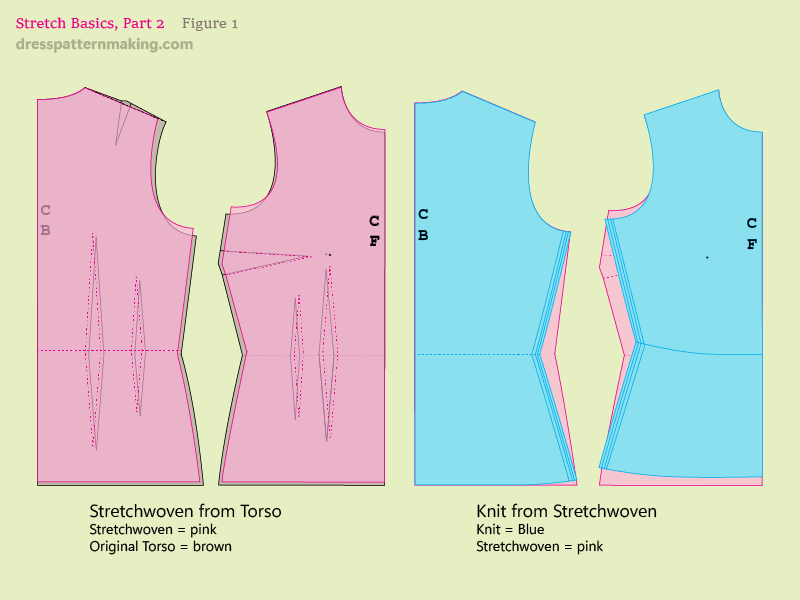
This s is Part 2 of a series of 3 articles. Click here to go back to Part 1, Introduction. As knit/stretch fabric comes in different stretch ratios, you need to create different blocks to work with each stretch radio. For example, you need to use a different Torso Block to draft a garment for each of the following fabrics:
- Stretchwoven* (18% stretch)
- Stable Knits* (18-25% stretch)
- Moderate Knit (26-50% stretch)
- Stretchy Knits (50-75% stretch)
- Super-Stretchy Knits (75-100% stretch)
*Although some Stretchwovens and Stable Knits stretch a similar amount, different blocks are used because Stretchwovens are treated as wovens and the block has darts. Knit Blocks are dartless. With all of the above I am limiting my examples to knits that require reduction in width. When working with four-way stretch knits for garments such as leotards, etc., you will need to make a further reduction in length. Making changes to the Torso Block means that you will also need to make the relevant changes to the Sleeve Block to make a Stretch Sleeve Block. In this article I am also limiting myself to the Torso Block; the same theory applies to other Blocks; i.e. you need to create a similar number of blocks for Skirts, Pants...etc. Although a fashion house would have a separate block for each of the above categories (and maybe even more blocks), the home sewer/patternmaker could get away with putting all the information for Knits on one block and tracing off the relevant information.
Drafting the Blocks
It is easiest to create the Stretchwoven Block from the (normal woven) Torso Block, then create the Knit Block from the Stretchwoven. While it is of course possible to draft the Knit Blocks from scratch, if you have already done the work of drafting a block that already has your shoulder slope, CF & CB Length, etc., it makes sense to start with that block rather than recreating the wheel.
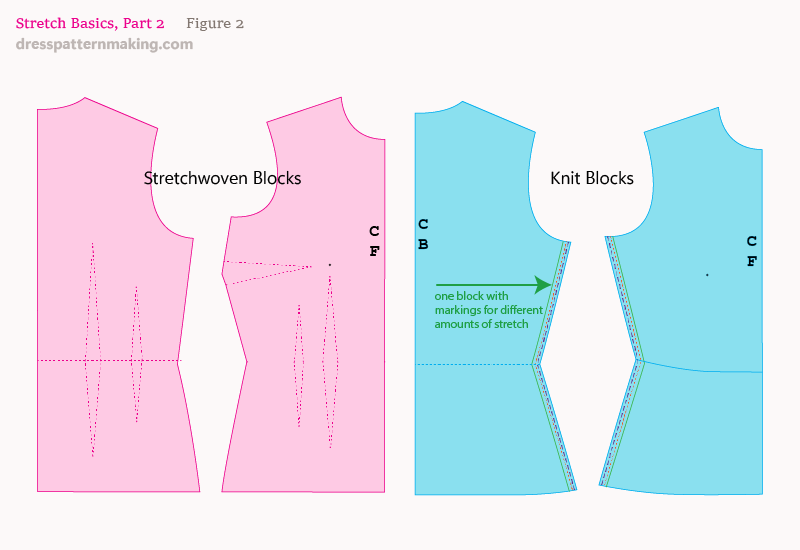
Why not identical Front & Back?
Note that in these Knit blocks I am showing you the Front and the Back Knit Blocks are not identical. Some (but not all) block making instructions do get you to draft the back of the Knit Block, then make the front the identical shape as the back except for the neck curve. If the shoulder slopes are different, then you split the difference. This method may work well for standard figures with a smaller bust cup, but won't work so well for large bust cups. I will cover this option within my Stretch Block Instructions for those who may find it easier and their body shape allows it.
Changes to (woven) Torso Block to create Stretchwoven Block
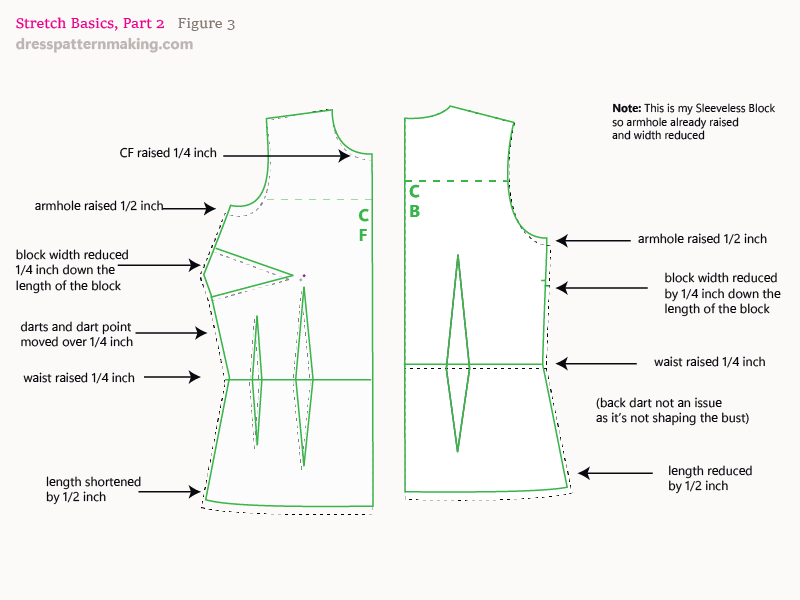
The standard woven Torso Block has the following changes made to make is a Stretchwoven Block. These are general guidelines that are a starting point for most people.
- Reduction in Width: about 1/4 -1/2 inch for the F&B, along the whole side seam.
- Armhole raised 1/2 inch
- Back shoulder dart removed
- Waist lifted 1/4 inch
- Length shortened 1/4 inch
- Center Front neck raised 1/4 inch
- Bust dart moved in towards CF 1/4 inch
- Side seam dart moved in 1/4 inch
- Waist darts raised with waistline
As already mentioned, Stretchwovens are treated as wovens, so the block has darts. When creating the Knit Block from this block, the darts are removed. Because this Torso Block has sleeves, the Sleeve Block will also need an adjustment so it fits the block. Important Note: I am giving exact values such as 1/4 inch; in the industry these would actually be percentages of the body measurements or the block. These concrete values are a good starting point for home sewers, but if you are in the very large size range, you might want to use the percentages listed in my articles on Stretch Basics.
Changes to Stretchwoven Block to make Knit Block
- Darts removed
- Try and get the F&B shoulder slope the same
- Try and get the F&B either identical or as close as possible.
- After the above changes are made, consecutive reductions in width, getting smaller each time, to make next block for the next knit stretch ratio.
- Each time a reduction in width is made, the armhole needs to be redrawn or trued.
Amount of Block Reduction
From a textbook dedicated specifically to Patternmaking for Knit, the industry standard for the Knit Blocks are:
- Stable Knit: Body Measurements - Therefore you would remove all your ease from your block for Stable Knits. (No Ease, No Reduction)
- Moderate Knits: Reduction of 2% (or 98% of) your Body Measurement. (Negative Ease)
- Stretch Knits: Reduction of 3% (or 97% of) your Body Measurement (Negative Ease)
- Super Stretchy Knits: Reduction of 5% (or 95% of) your Body Measurement (Negative Ease)
The above textbook doesn't mention Stretchwoven, it just says a reduction in width is required.
However.... I found the above information after I watched tutorials made by home sewers and/or standard patternmaking textbooks, which suggest a lesser reduction. Many of the patternmaking tutorials and other information I found before I found this have suggested taking 2%, 3%, 5%... off your block, and given your block contains ease, the reduction is much less than suggested above in the Knit Textbook. Whether you decide to try reducing your block, which contains ease, or just use the percentage of your body measurements so all of your knits except Stable end up with negative ease, is up to you. The first toile I made was for a Sleeveless Garment, and I used my Sleeveless Block, which already has some ease taken off. I reduced that by 1/4 (approx 2%) on the F&B, and make a test toile with Stretchwoven fabric. I ended up with a well fitting dress. I then used the same block to make the same dress from knit fabric with moderate stretch (50%) and it worked well too. It could have been closer fitting, but I liked it fine as it was. Note also that I put in dart equivalents (princess seam-line) and seam-lines, and I really like it.
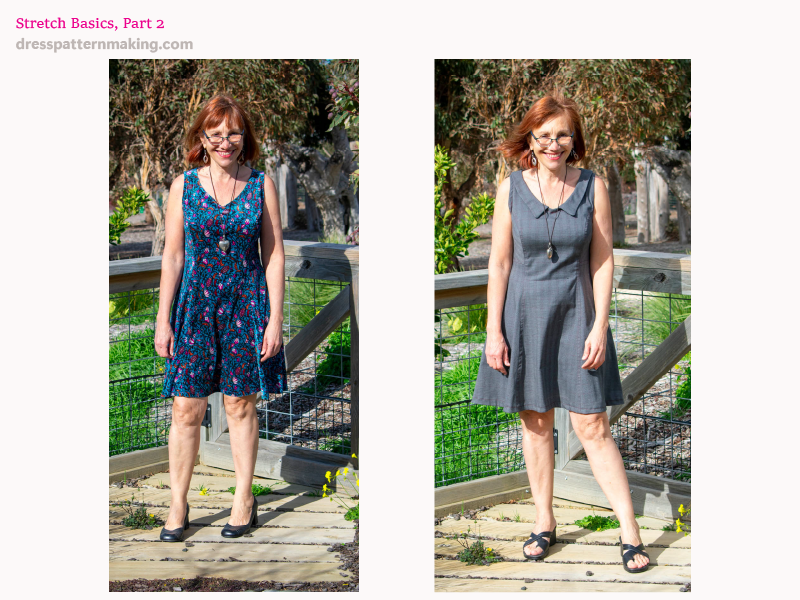
Which leads me to the next topic.... darts.
Knits & Dartless Blocks
Given that knits stretch, you don't need darts. Also, minimal design lines are required. Well, that's the prevailing wisdom, and that's why Knit Blocks are dartless.HOWEVER... Let me give you my observations and opinion... feel free to ignore it. (Note that my last image above shows a dress made with a knit that has a dart equivalent and design lines). Firstly: if you take a good look at a lot of knits, they may not have darts, and they may have been drafted with a dartless block, but they may actually have a dart equivalent in the form of fullness. I watched a tutorial where someone drafted a knit garment with a dartless block, then they added in design ease at the neckline to create gathers. The extra ease in the neckline is a DART VALUE by any other name. This type of top would suit large busted women far more than a t-shirt with only side seam shaping. Not only suit better, but fit better. Secondly: I challenge you to take a really good objective look at knit garments on yourself or on other people. Note that even though the person might think they are comfortable, there may be signs that it's not fitting that well; pulling and strain lines at the armhole. Pulling at the bust. While we have this idea that knit is super comfortable and we can get away with using all the stretch that is in a fabric, sometimes it doesn't actually look that good. Thirdly: It's in the Fashion Industry's best interest to make garments that have no darts and design lines; less work, more profit. Apparently it is not 'fashionable' to have too many design lines in knit fabrics. Again, that is in their interest, and is better for their bottom line. I think that if you have a large bust or are very curvy (large differences between your high bust/bust/waist/hips) you should experiment with design lines, or at a minimum design with extra fullness so the garments do fit better.
Dress made from jersey knit with princess line
I tested making a dress from a (cheap and a bit ugly, but you don't want to use nice fabric for toiles when experimenting) stretch jersey with the same princess lines as the stretchwoven and velvet dresses above. For me it is far more comfortable than other jersey dresses I have that have no bust shaping. I made it from my Stretchwoven Block, so it is a bit shapeless, but I plan on trying again with a nicer fabric and taking some of the ease out (i.e. making it with a more appropriate knit block).
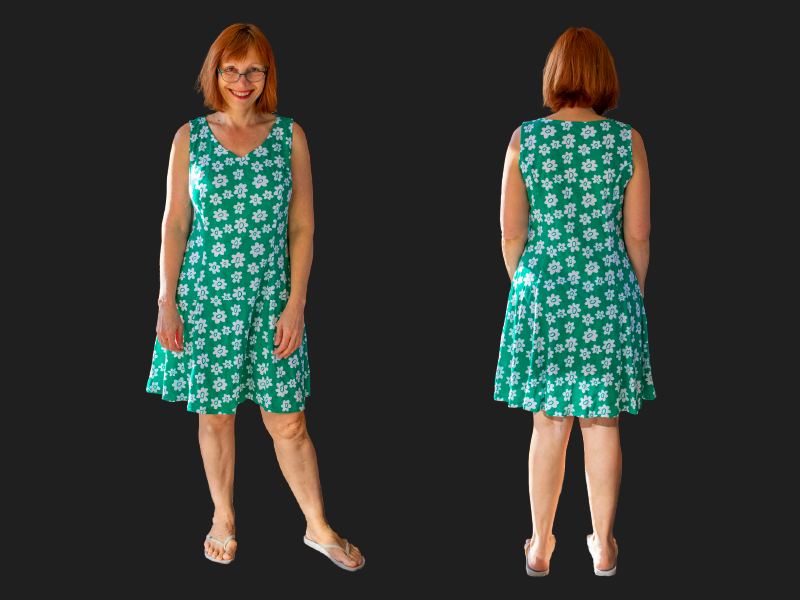
Continue: Stretch Basics for Patternmaking Part 3 - Challenges for Non-Standard Figures

